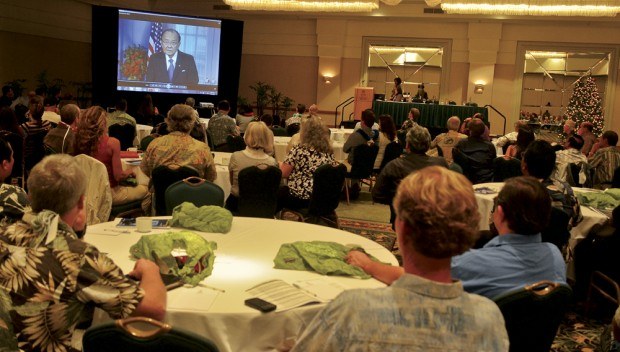LIHU‘E — “Investing in Kaua‘i’s Energy Future Today” was the focus of this year’s Energy Conference presented by Kaua‘i Economic Development Board Tuesday in Lihu‘e. “Hawai‘i (state) has the highest energy prices in the nation,” said Sen. Daniel Inouye, D-Hawai‘i,
LIHU‘E — “Investing in Kaua‘i’s Energy
Future Today” was the focus of this year’s Energy Conference
presented by Kaua‘i Economic Development Board Tuesday in
Lihu‘e.
“Hawai‘i (state) has the highest energy prices in the nation,” said
Sen. Daniel Inouye, D-Hawai‘i, in a pre-recorded video address.
“Kaua‘i has the highest prices among the islands … We must have the
political will to stay the course (with renewable energy). We can’t
afford not to.”
The overall message of the conference couldn’t be more clear: An
abundance of natural resources — such as sun, wind and water —
along with political will and a combination of public and
private-sector investment, make Hawai‘i poised to meet its goal of
70 percent renewable energy production by the year 2030.
There was also an underlying message: What’s taking so long?
“We find ourselves playing catch up to other countries,” James
Spaeth, Pacific Region senior advisor for the U.S. Department of
Energy’s Office of Energy Efficiency and Renewable Energy, said of
the U.S. “We’re third in high-tech energy investment behind China
and Germany. As a percentage of (gross domestic product), we’re
about number seven. We’re behind our neighbors in Canada and the
United Kingdom — and even countries like Spain, having such
challenging economic times.”
DOE’s main focus is energy security, he said, which includes three
major pillars: national security, environmental security and
economic security. Last year’s DOE budget was $25 billion.
Three-fourths of that budget is spent on nuclear security and
nuclear-energy related issues.
“So a small fraction, approximately $8 billion, is spent on energy
development,” Spaeth said. A small percentage of those funds are
focussed on employment and technologies that are already ensured.
Approximately $50 million per year is spent on energy-related jobs
and $1.8 billion goes toward research.
“Now we’re into fiscal year 2012,” he said, “and we still don’t
know what our funding will be because (they) still haven’t passed a
budget, but every agency is seeing major pressures and
cuts.”
Compared to the rest of the nation, Hawai‘i ranks first in solar
water heaters, second in photovoltaic energy and third in
energy-related jobs, he said.
Glenn Sato, who Mayor Bernard Carvalho Jr. promoted in September to
the his newly created position of sustainability manager, said the
county is making its own strides toward sustainable and renewable
energy by upgrading county facilities, installing renewable energy
systems where feasible and transitioning the county’s fleet to
hybrid and electric vehicles.
Over the last year, the county has installed photovoltaic panels on
the Civic Center and Kaiakea Fire Station, and purchased five
all-electric Nissan Leafs. Charging stations will be installed in
the near future.
Upcoming clean energy projects include a county-Navy methane
project at Kekaha landfill, biogas energy generation at various
sewer treatment plants around the island and additional
photovoltaic installations at the police department, the office of
the prosecuting attorney and civil defense.
Local energy developers — such as Kaua‘i Island Utility
Cooperative, Free Flow Power, Gay & Robinson, Pacific Light
& Power and Green Energy — provided brief descriptions of their
renewable energy plans for Kaua‘i for the coming year and beyond,
which include solar power, hydropower, biomass and the smart
grid.
• Vanessa Van Voorhis, staff writer, can be reached at 245-3681
(ext. 251) or by emailing vvanvoorhis@thegardenisland.com.


